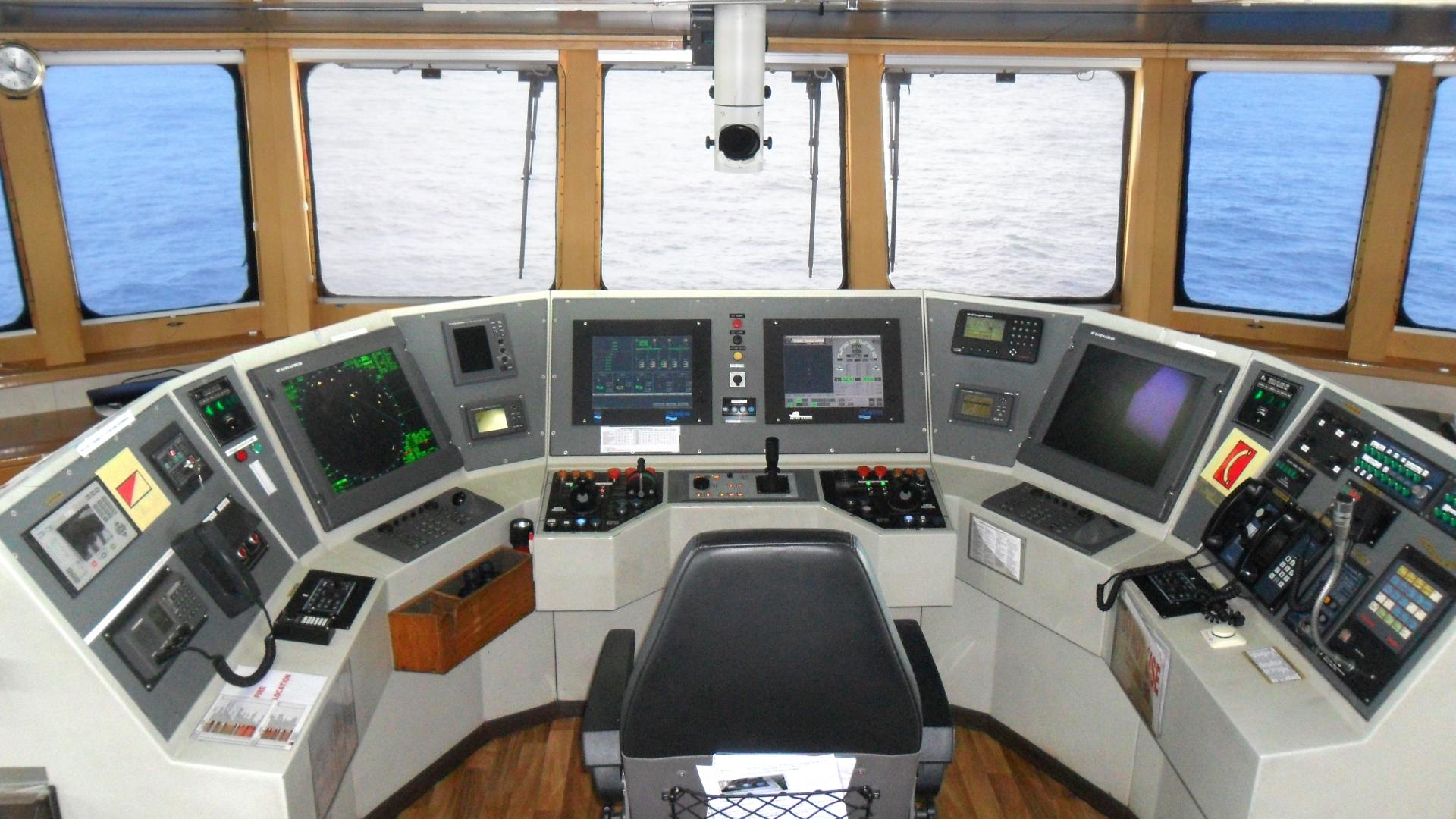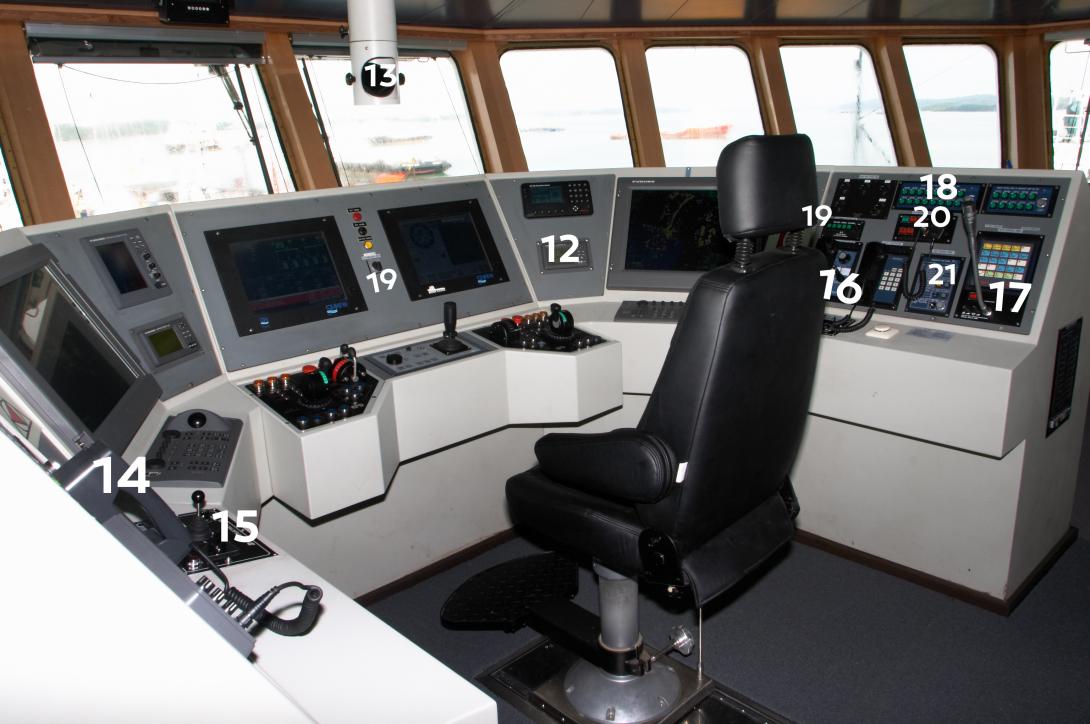
The bridge of the Bourbon Liberty 101: episode 2
Continuation and ending of the guided tour aboard the Bourbon Liberty 101, a diesel-electric DP2 PSV (Platform Supply Vessel), dedicated to supplying offshore facilities, with its captain Didier Calvo, who describes the navigation station for us.
Review episode 1 before starting reading.

After clicking on the photo, see the description of each equipment below.
12 - Automatic Identification System (AIS)
AIS is an automated system for exchanging messages between vessels using VHF radio, which enables vessels and traffic control systems to know the identity, status, position and route of vessels located in the navigation area. This device appeared in the early 2000s in order to deal with the many collisions between vessels due to misidentification.
13 - Pelorus
Behind this strange name hides a magnetic compass viewing system. Like a periscope using a set of mirrors, the seafarer can read the heading on the magnetic compass. It remains a last-resort emergency navigation tool in case the gyrocompasses are unavailable.
14 - VHF (Very High Frequency)
VHF radio is the first communications device for the bridge to use when communicating with other vessels, offshore installations and the shore. Channel 16 is dedicated exclusively to distress calls. This channel is also used as a general calling frequency but communications must continue on another channel. Since the early 2000s, DSC (Digital Selective Calling) has appeared on VHF devices. DSC makes it possible to selective and discreetly call a vessel or a land station and, at the touch of a button, send an automatic distress alert to any station.
15 - Searchlight control panel
The vessel is equipped with 3 searchlights, 2 fore and one aft. Controllable from inside using a joystick, their powerful beam makes it possible to sweep the surface of the water at night when searching for a man overboard, a floating object, or to identify a small craft approaching too close.
16 - Self-generating telephone
This device has the distinction of being independent of any external power source. It is mainly used in the event of a black-out on the vessel. After selecting the handset to call, you turn the crank, which in addition to actuating a bell, lets you turn a dynamo that will charge the circuit, making it possible to communicate.
17 - Public address
As the name suggests, this equipment allows for targeted or general broadcasts. These broadcasts are general or safety messages.
18 - Control of outdoor lighting
This console is used to control all the exterior-facing lights at night. It is divided into 3 parts:
- in port: lighting throughout the vessel
- at the post of maneuvering station: lighting of the forecastle and quarter deck
- during operations under oil installations: lighting of the rear deck with powerful spotlights
19 - Foghorn
An essential device for the vessel, the foghorn is used, following an established code:
- to report its presence to other vessels in case of fog or poor visibility
- to report its maneuvers to other vessels
- to report to the other vessel that our maneuver is misunderstood
20 - Distress signals
This equipment is programmed to broadcast a specific alarm onboard the vessel for each serious situation:
- fire alarm / flooding / injury: 1 long blast
- man overboard alarm: 3 long blasts
- abandon vessel: 7 short blasts – 1 long blast
Once the seafarer hears this alarm, he must go to his station to perform a precise task defined on the muster list.
21 - ISPS console
As on land in some companies, the vessel is subject to strict security rules in order to prevent any intrusion. This console monitors the closing of all doors to the exterior. If the console is activated, an alarm will sound if an exterior door that shouldn't be opened is opened.
Not visible in the photo:
Fire Console
On the left, a fire panel brings together all the fire sensors and push button alarms. There are 2 types of onboard sensors: smoke and heat.
BWNAS (Bridge Watch Navigation Alarm system)
This system, recently installed on the vessel, monitors whether the seafarer on the bridge is still conscious.
Mainly active during the day when the sailor engages the autopilot, the system triggers a countdown. This countdown timer, set by the captain, is reset if the motion sensor detects the motion of the seafarer on the bridge.
Otherwise, an alarm sounds on the bridge. If the seafarer fails to acknowledge the alarm after 1 minute, the alarm sounds in the captain's cabin. If the alarm is still not turned off after one minute, the general alarm is sounded throughout the vessel.


